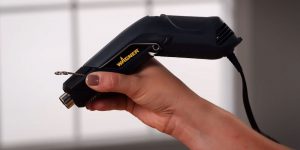If you’re looking for an easy way to strip paint from a surface, you may be wondering if a heat gun can do the job. In short, the answer is yes – a heat gun can help you remove paint from many surfaces.
However, there are some things you should know before using one to strip paint. In this blog post, we’ll discuss the basics of using a heat gun to strip paint, as well as some tips to make the process easier.
Why is it better to use a heat gun to remove paint?
One of the main reasons people use heat guns to remove paint is that it is a quick and easy way to do it. A heat gun can strip paint much faster than other methods, such as sanding or using chemical strippers.
Another reason why people use heat guns is that they can be used to remove paint from difficult-to-reach areas, such as corners or crevices. A heat gun can get into these tight spaces more quickly than other tools, making it an excellent choice for removing paint from hard-to-reach surfaces.

What temperature should it be to strip paint with a heat gun?
The temperature of the heat gun is essential when stripping paint. If the heat gun is too hot, it can damage the surface you are trying to strip. On the other hand, if the heat gun is not hot enough, it will take longer to strip the paint.
Most heat guns have a temperature range between 250-1000 degrees Fahrenheit. It is best to use the lower end of this temperature range when stripping paint. It will help prevent damage to the surface you are working on.
What are the nozzles for a heat gun?
Most heat guns come with different nozzles that can be attached to the end of the gun. These nozzles help focus the heat on a specific area, which can be helpful when you are trying to remove paint from a small area.
Some of the most common nozzles for heat guns are:
- The reflector nozzle – this nozzle helps to reflect the heat onto the surface you are stripping.
- The diffuser nozzle – this nozzle helps to spread the heat out over a larger area.
- The scraper nozzle – this nozzle helps remove paint from flat surfaces.
- The spiral nozzle – this nozzle helps remove paint from curved or difficult-to-reach surfaces.
- Reducer nozzle – this nozzle is used for stripping smaller objects, such as car rims or small parts.
- Glass protector nozzle – this nozzle is used to protect glass surfaces from heat damage.
- Flat nozzle – this nozzle creates a flat area of heat.
As you can see, many different nozzles can be used with a heat gun to help with paint stripping. Choosing the proper nozzle for the job you are doing is essential, so it is a good idea to experiment and try out different options until you find one that works best for you.

What are the safety concerns with using a heat gun?
You need to be aware of some safety concerns when using a heat gun. One of the biggest dangers is the risk of fire. If you are not careful, the heat from the gun can easily ignite any flammable materials nearby.
Another danger is that the heat from the gun can cause serious burns. If you accidentally touch the surface being heated, it can result in serious burns. To reduce the risk of injury, you should always wear proper safety gear when using a heat gun to strip paint.
Overall, using a heat gun to strip paint is an effective and efficient way to remove old paint from surfaces. However, it is crucial to be aware of the risks and take proper safety precautions. If you follow these tips, you can safely and effectively use a heat gun to remove paint from any surface.
Will a heat gun remove gloss paint?
A heat gun can remove most types of paint, including gloss paint. The heat from the gun will cause the paint to blister and peel off the surface. However, it is essential to be careful when using a heat gun on gloss paint, as the heat can damage the surface beneath the paint if it is not adequately protected.
Will a heat gun remove paint from metal?
A heat gun can be used to remove paint from metal surfaces. Ideally, the heat gun’s temperature should be between 150 and 450 degrees Fahrenheit. However, if you are working with lead-based paint on metal, the temperature should be between 1,200 and 1,500 degrees Fahrenheit in order to remove all of the paint effectively.

Will a heat gun remove paint from wood?
A heat gun can be used to remove paint from wood surfaces. The heat from the gun will cause the paint to blister and peel off the surface. However, it is essential to be careful when using a heat gun on wood, as the heat can damage the wood if it is not adequately protected.
You should always test the heat gun on a small area of the wood first to ensure that the heat will not damage it. If you are working with lead-based paint on wood, the temperature should be between 1,200 and 1,500 degrees Fahrenheit to effectively remove all of the paint.
Will a heat gun remove paint from plaster?
A heat gun can be used to remove paint from plaster surfaces. The heat from the gun will cause the paint to blister and peel off the surface, making it much easier to scrape or wipe away. However, it is vital to take precautions when using a heat gun on plaster, as the heat can cause damage if it is not adequately protected.
When should you not use a heat gun?
There are a few situations where you should not use a heat gun. One is when you work with lead-based paint, as the high temperatures can release harmful fumes. Another is if the surface you are working on is made of glass, as the heat can damage the surface. Finally, you should not use a heat gun on plastic, as the extreme heat can cause it to melt or warp. You should always be cautious when using a heat gun and take appropriate safety measures to protect yourself and your surroundings.

















